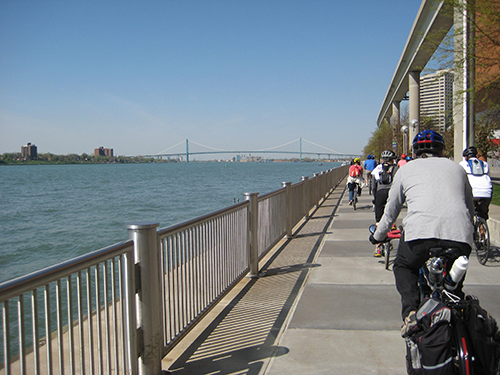Jun 17 2016 Lessons in establishing a governance structure from the Detroit Riverfront Conservancy
 From The Intersector Project Case Library: Redeveloping the Riverfront in Detroit
From The Intersector Project Case Library: Redeveloping the Riverfront in Detroit
For decades, the riverfront in Detroit was dotted with run-down industrial sites, parking lots, and overgrown shrubbery, rendering it inaccessible to the general public. In 2003, a group of local leaders from the Kresge Foundation, representatives from the City of Detroit, and General Motors, spearheaded by GM executive Matt Cullen, saw the potential for positive redevelopment, and formed the Detroit RiverFront Conservancy (DRFC), a non-profit organization with plans to collaboratively turn five and a half miles of riverfront property into a pedestrian-friendly walkway that would attract private and public interest in the space.
Establish a Governance Structure
The Detroit RiverFront Conservancy is led by a constituency-based group of 44 members who constitute the Board of Directors. Members include private and public participants, many of whom participated in the original feasibility study for the DRFC. The organization has strived over the years to incorporate all relevant input from the community— prior attempts to revitalize the riverfront have failed, in part, due to the lack of incorporation of diverse interests of community members. Stakeholder diversity has been a key factor leading to the sustainability of the DRFC; one-third of board members are women, and another third represents racial minorities. The Board of Directors’ active participation includes attending fundraising efforts, community feedback forums, and policy meetings, as well as providing overall advisory support for the DRFC.
DRFC’s Board is an excellent example of how to Establish a Governance Structure — the creation of a formal or informal organizational system for decision making and project management. Clear governance structures, such as committees, workgroups, or facilitated discussions, provide direction while nurturing equity and inclusivity to resolve actual or perceived power imbalances that can arise during collaboration.
Based on their organization- and sector-specific experiences, as well as the cultural context in which they have operated, partners may have differing understandings of “inclusivity.” Inclusivity is key to the collaborative process—It encourages investment in the collaboration by nurturing consistent, meaningful engagement, can lay the groundwork for resolution of perceived or actual power imbalances, and can ease partners’ acceptance of collaboration decisions that may not align with their interests. The collaboration can nurture equity and inclusivity through its governance structure in many ways, including providing for the equal allocation of speaking time during meetings, formalizing voting processes, and more. If partners perceive the governance structure to be exclusive, they may become frustrated, lose confidence in the collaboration, and disinvest.
From 2003 to 2014, the Conservancy transformed the waterfront into a manicured and beautifully landscaped, bicyclist- and pedestrian-friendly public area with parks, plazas, pavilions, and open green spaces. The DRFC also hosts a variety of events and programs to encourage visitors to remain active and enjoy the outdoors. This redevelopment has attracted further investment in the area with restaurants and other businesses moving to the riverfront, continuing the revitalization of the city’s riverfront space. A 2013 economic impact study revealed that there has been more than one billion dollars of public and private investment in the riverfront within the first 10 years of the DRFC’s existence.
As Detroit leaders plan to redevelop another 400 acres of riverfront, they will be trying to balance the need for economic development with the desire to “avoid making the east riverfront a gated enclave for the wealthy,” reports the Detroit Free Press. A governance structure that values diversity of viewpoints is likely to help the Conservancy through this next phase of development.
For further guidance on establishing a governance structure, we suggest that partners reflect on these questions:
- What different governance structures will we consider?
- How will we determine what type of governance structure is a best fit for our collaboration?
- How will we handle disagreements among partners when establishing a governance structure?
- How will our governance structure ensure equity and inclusivity?
- How will our governance structure address power imbalances?
- What is the relationship between our governance structure and how we have decided to share decision-making authority?
- Will we formalize our governance structure? If so, how?
For additional guidance, see these resources:
“Developing an Organizational Structure for the Initiative” from Community Toolbox
Especially see Section 1: Organizational Structure: An Overview for helpful guidance on choosing the best governance structure type for a collaborative initiative. (Other sections in this chapter may also be useful for detailed guidance on particular types of governance structures.) Community Toolbox is an online collection of toolkits and resources for individuals seeking to work collaboratively to bring about social change.
“The Partnering Toolbook” from The Partnering Initiative
Especially see Tool 3: Sample Partnering Agreement on p. 45 for a simple template for initial partnering agreements. A partnering agreement is developed between parties as an agreement to collaborate and often includes details on how the collaboration will be governed and decisions will be made. “The Partnering Toolbook” is a comprehensive guide to partnering across sectors.
“Building an Accountability Structure” from StriveTogether
Especially see pp. 23-26 for a discussion of how partnership agreements, MOUs, and bylaws can be helpful in formally capturing the governance structure (“accountability structure”) upon which partners have agreed.
